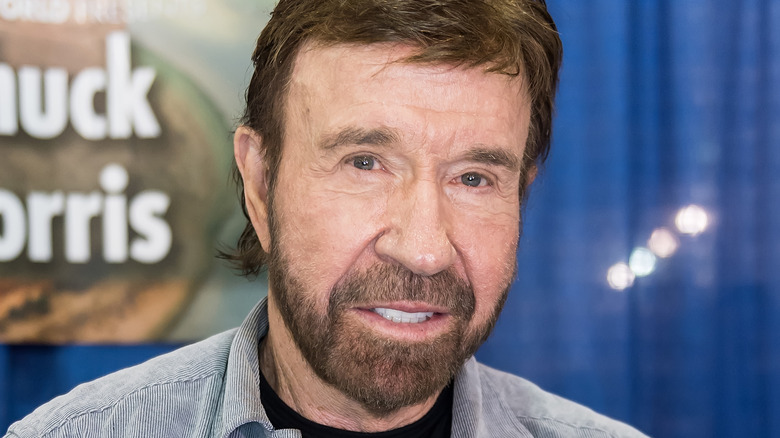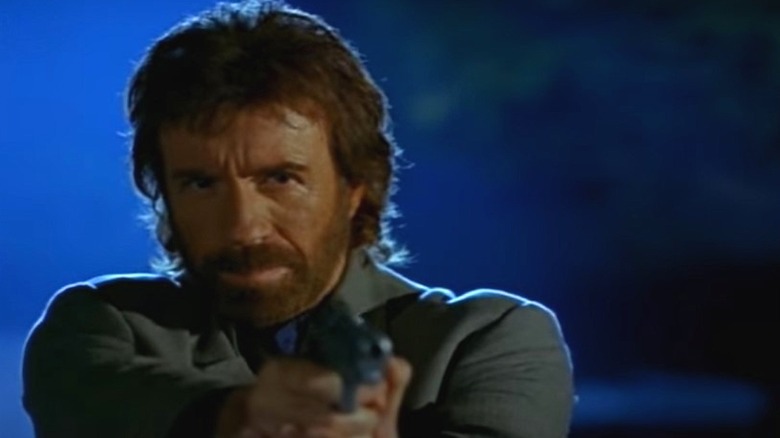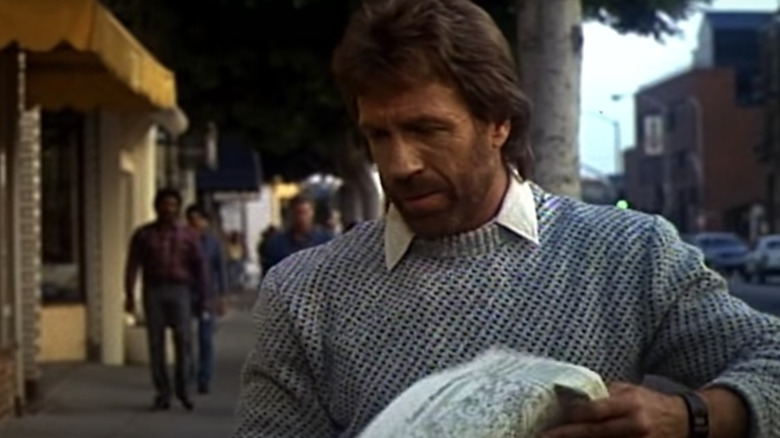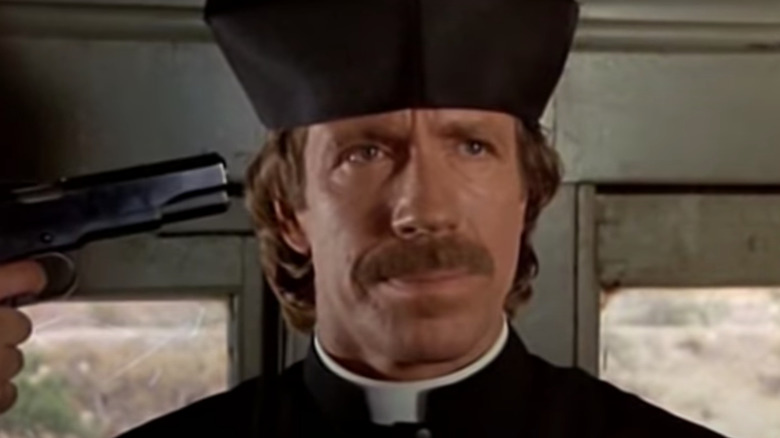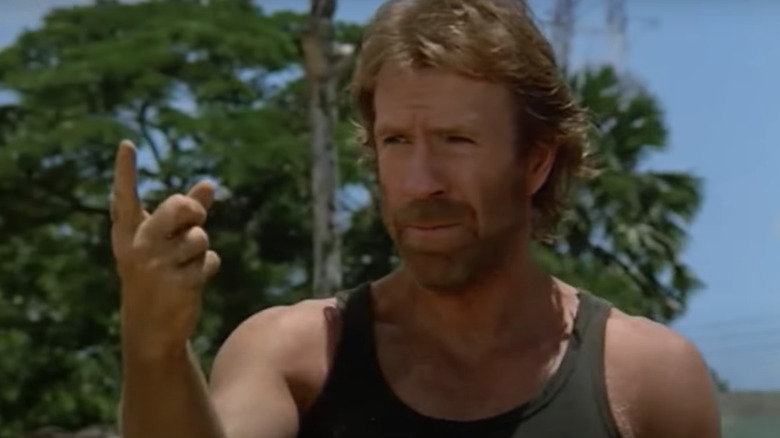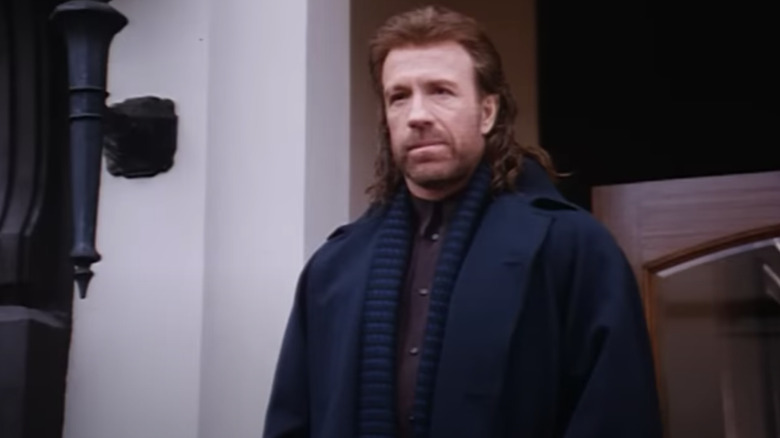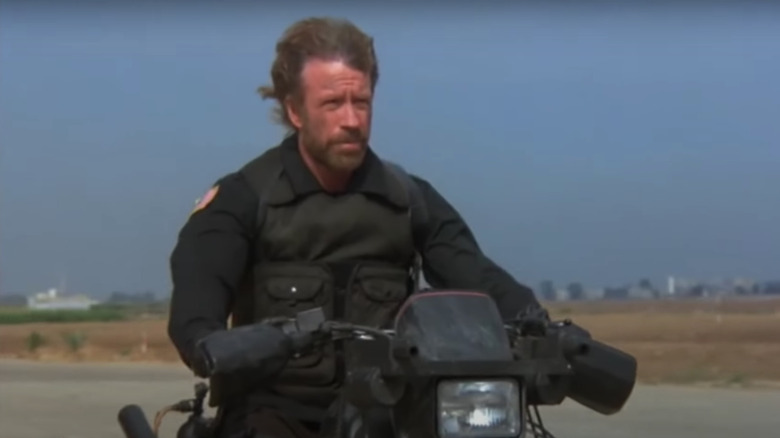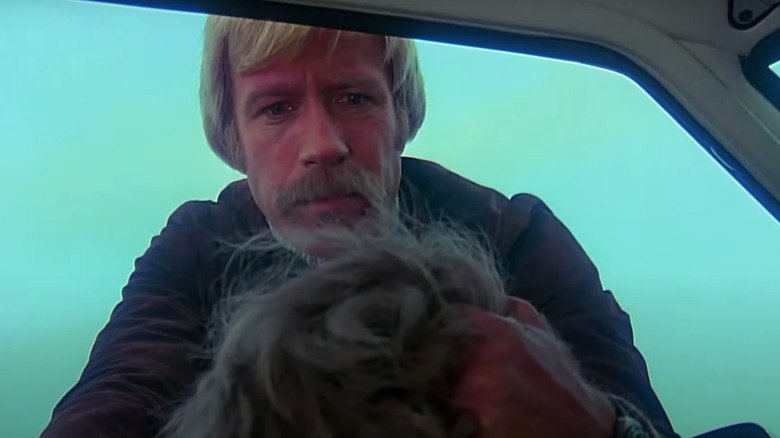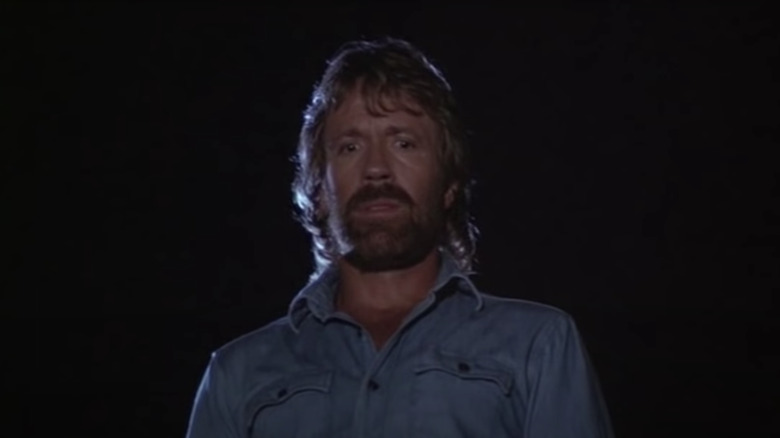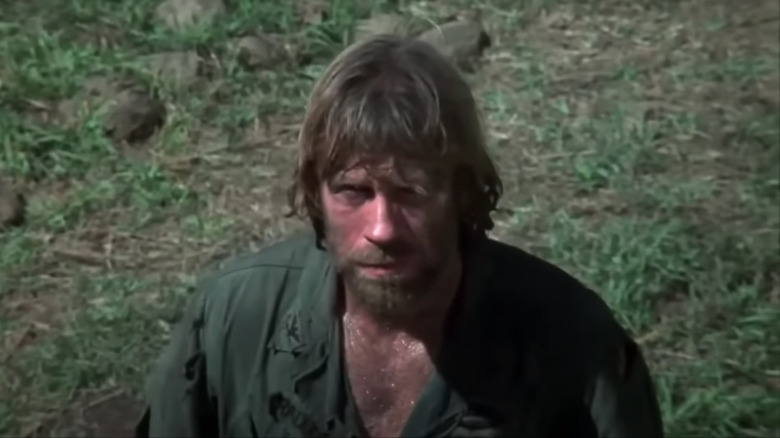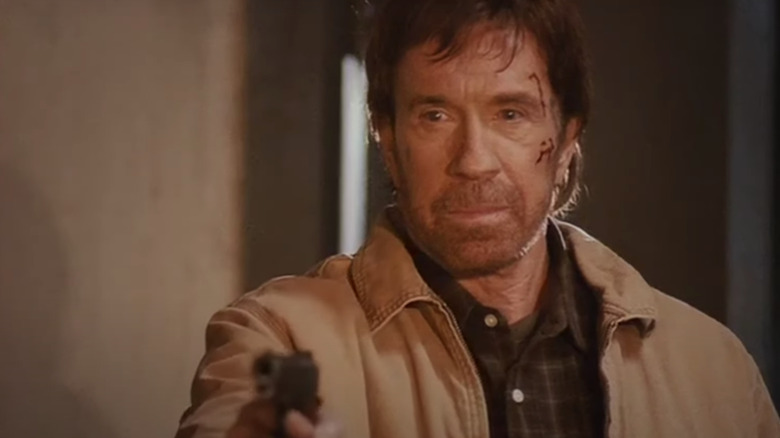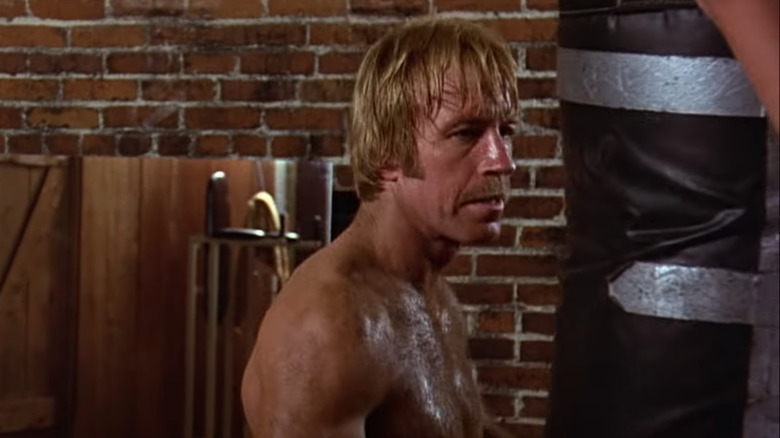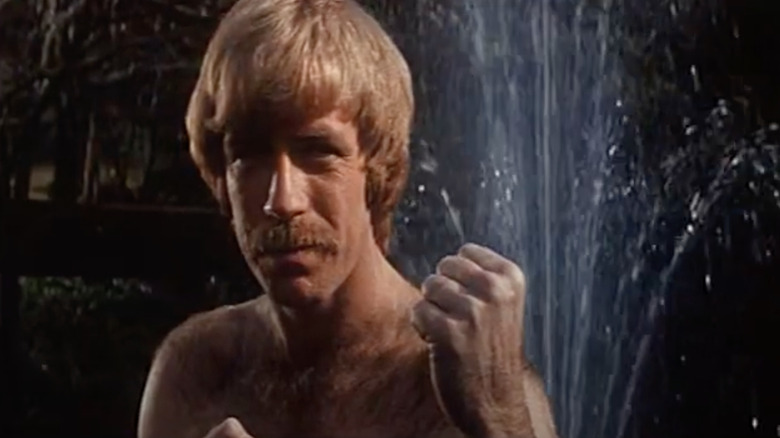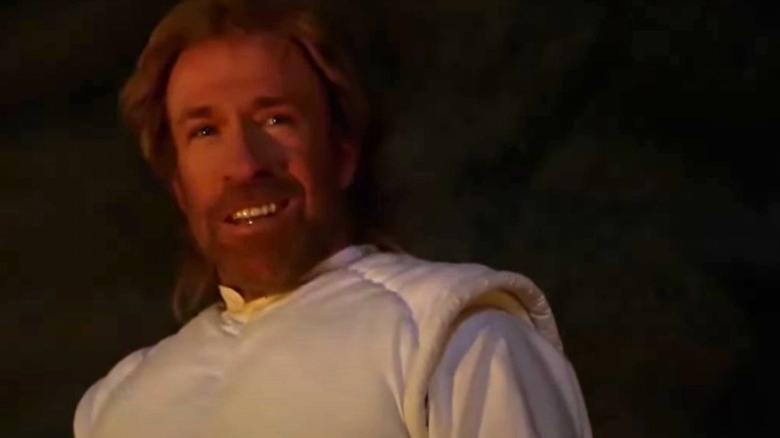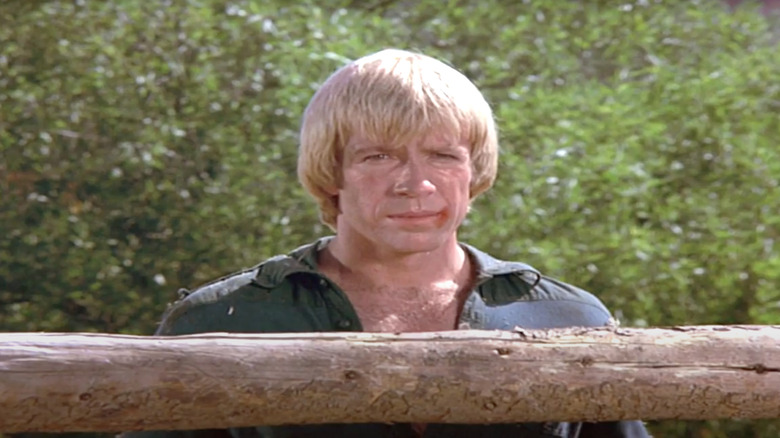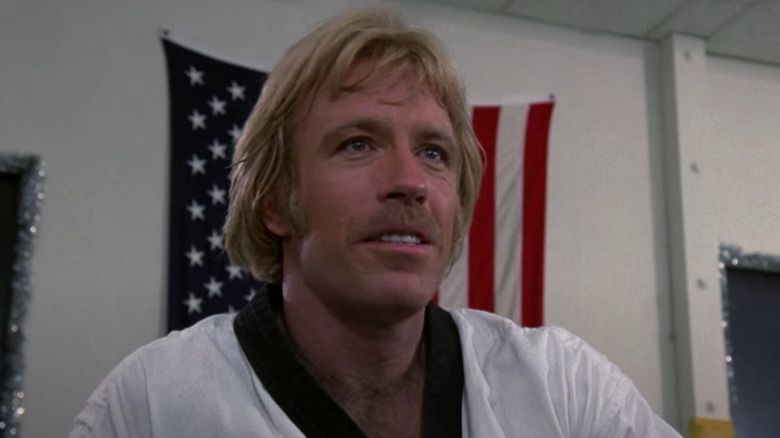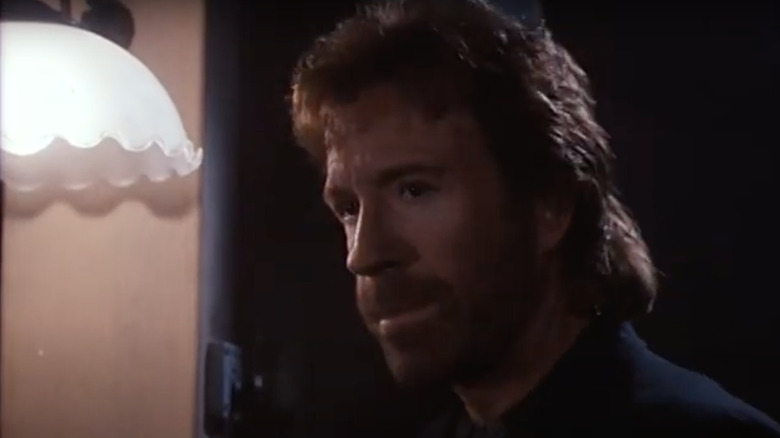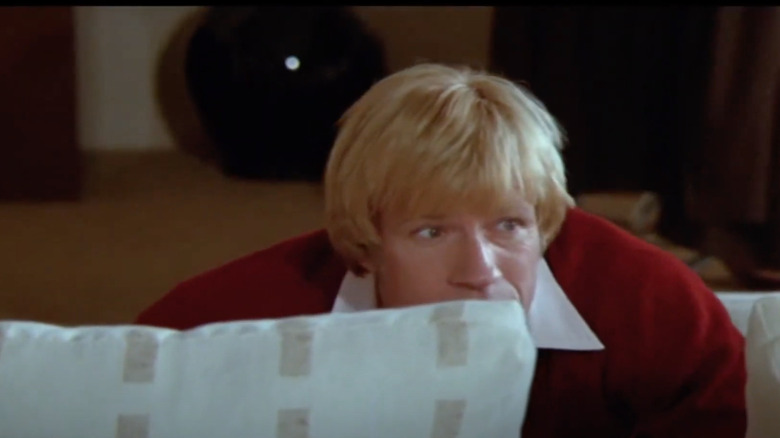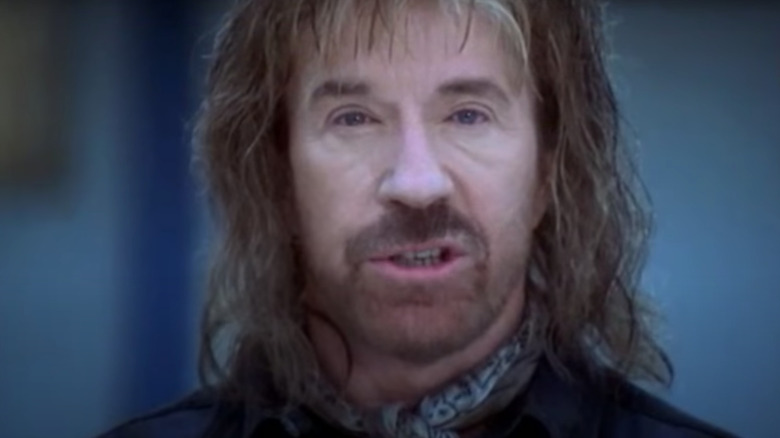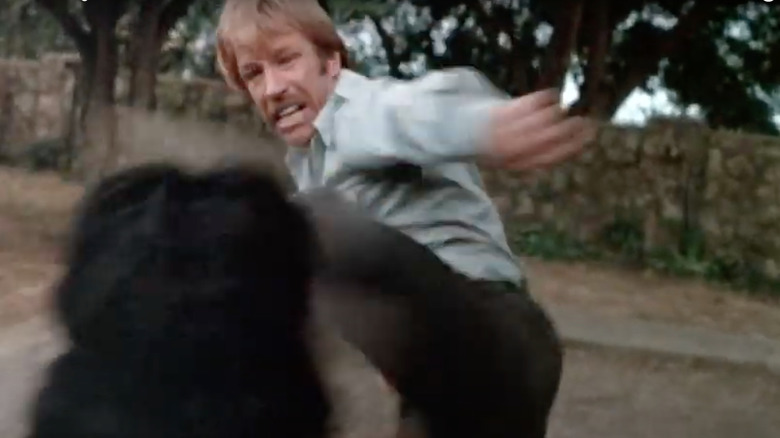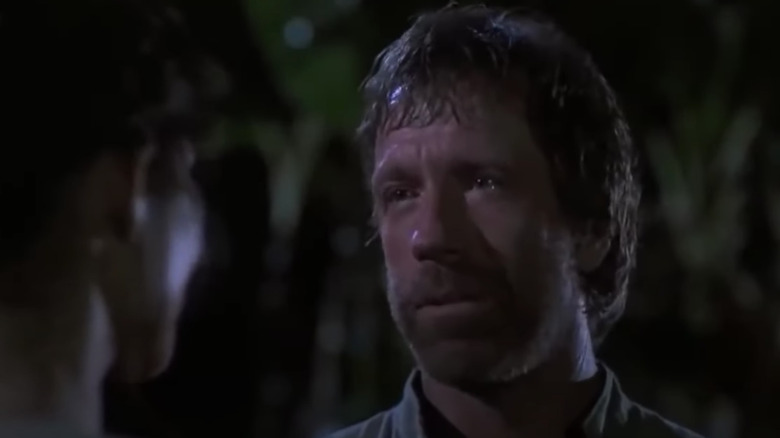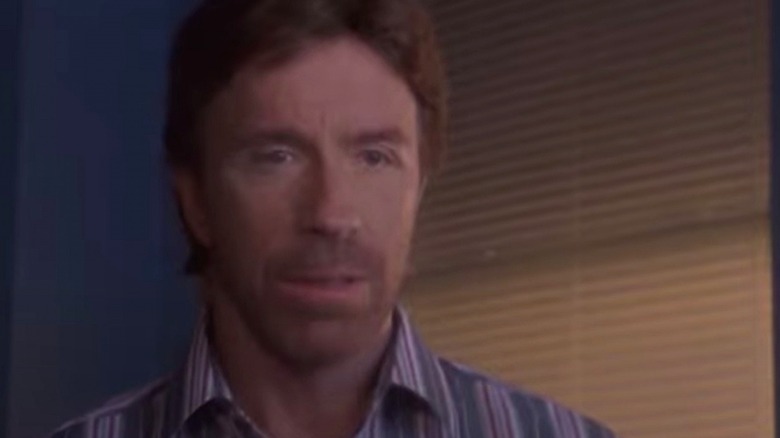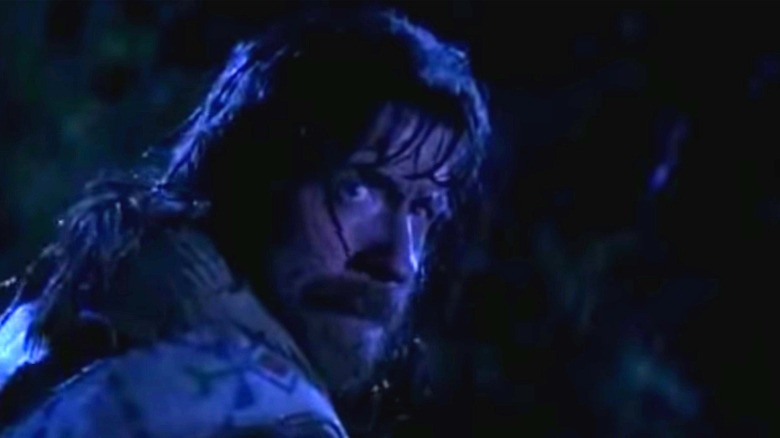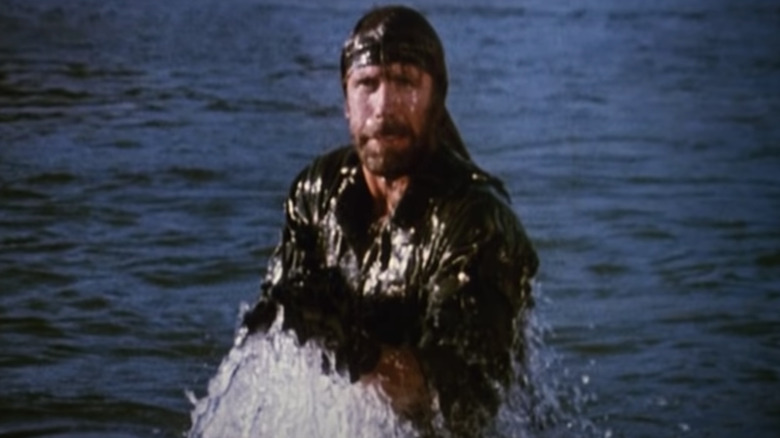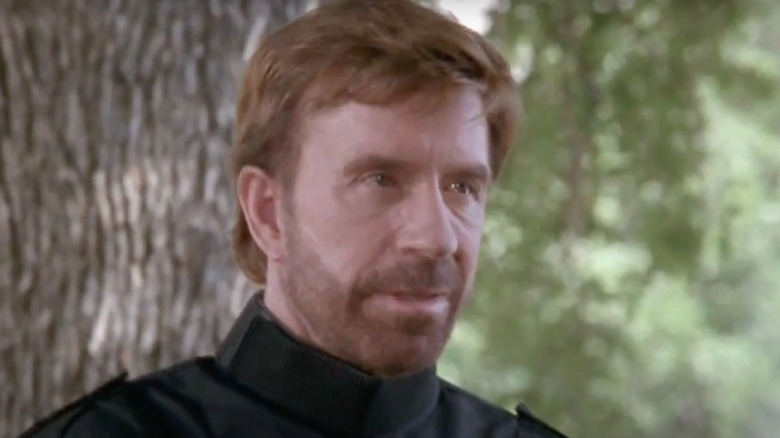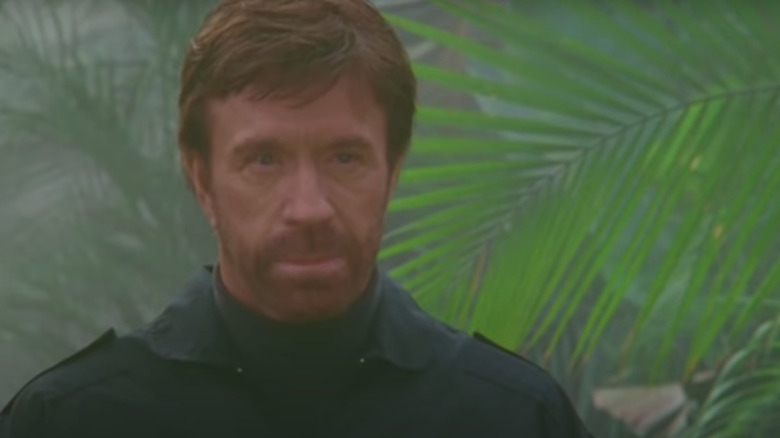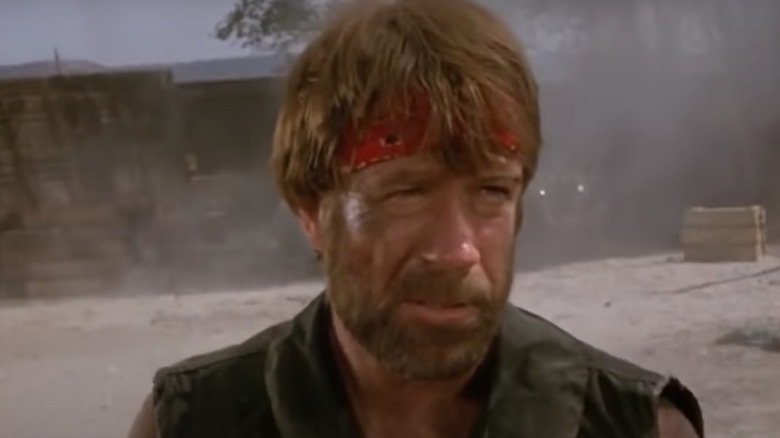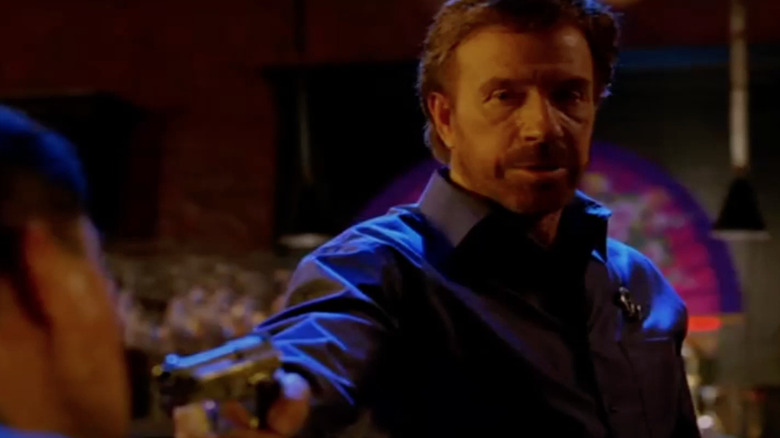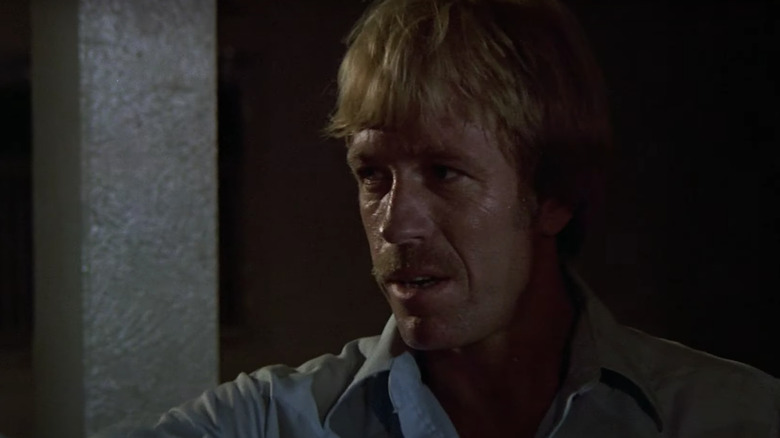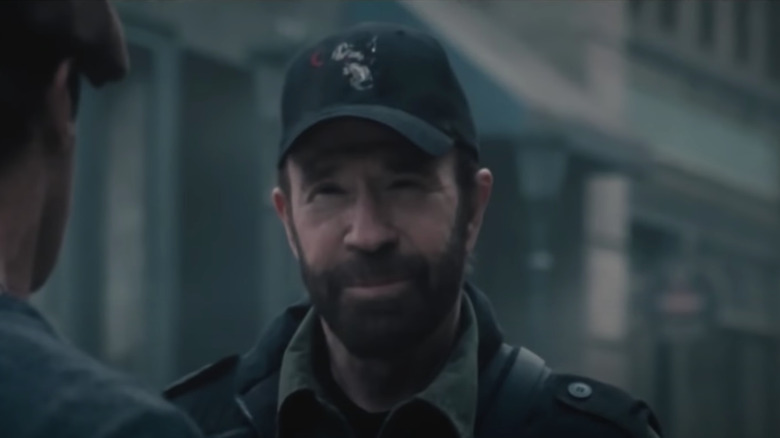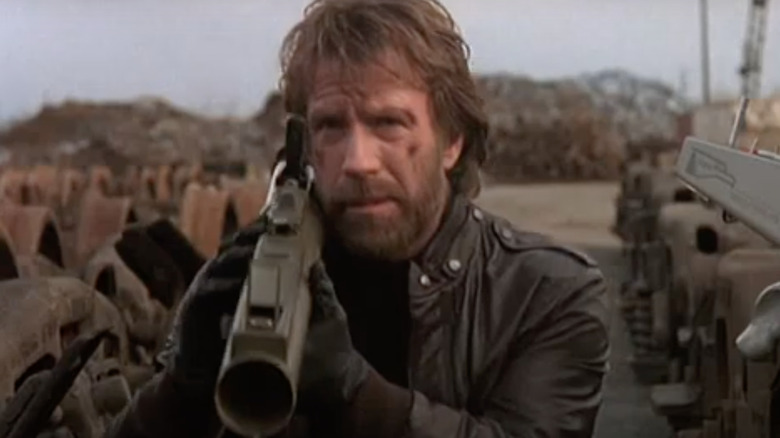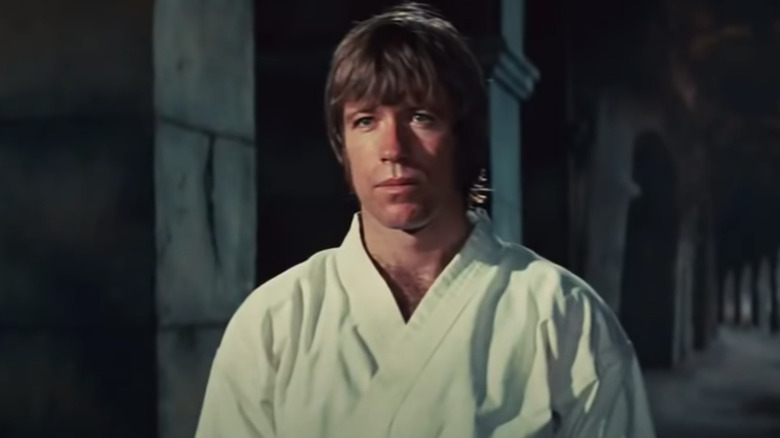Every Chuck Norris Movie Ranked From Worst To Best
From Arnold Schwarzenegger and Sylvester Stallone to Jean-Claude Van Damme and Steven Seagal, there were plenty of musclebound stars who dominated the action-hero market of the '80s and '90s Hollywood. Only one action star was deemed cool enough to have an entire genre of jokes based on him. "Chuck Norris' tears cure cancer. Too bad he has never cried," "There is no chin behind Chuck Norris' beard. There is only another fist," "Chuck Norris does not own a stove, oven, or microwave, because revenge is a dish best served cold," and hundreds of other Chuck Norris jokes have essentially superseded his movie career at this point and made him more myth than man.
Chuck Norris, born Carlos Ray Norris, used his background as a martial-arts world champion to bring legitimacy to his fight scenes after breaking into the film industry in the 1970s. When looking back at the totality of Norris' filmography, it might come as a surprise to find that most of his movies were total duds, though there are a couple of highlights amongst the chaff. Let's examine every Chuck Norris movie and determine which are worth checking out and which are worth skipping by ranking them from worst to best. Rotten Tomatoes scores determine the ranking, and cameos are excluded, such as his memorable appearance as himself in "Dodgeball: A True Underdog Story."
31. Top Dog
Chuck Norris' absolute worst movie is the 1995 action comedy "Top Dog." With a 0% score from Rotten Tomatoes critics, it really couldn't get any worse than this. The story is ostensibly a buddy-cop movie, but instead of pairing Norris up with a human partner, he works in tandem with a shaggy police dog. The cop-and-dog pairing had already been mined for humor in both "K-9" and "Turner & Hooch" several years earlier. "Top Dog" is the worst of the bunch by a significant margin, with both of those earlier cop-dog pairings already landing rotten scores across the board to begin with.
Though the premise and certain aspects of the presentation of "Top Dog" make it seem as though the film would be aimed at children, it was instead rated PG-13 and featured a tonally inconsistent plot that vacillates between goofy humor and violent fights against white supremacists. This tonal clash in the core premise baffled famed film critic Roger Ebert, who wrote in his one-star review, "Why, exactly, would you want to make a movie about racist hate groups, and then disguise it as family entertainment about a cute dog?"
30. Hero and the Terror
"Hero and the Terror" is on the same abysmal footing as "Top Dog," with a straight-up goose-egg 0% score from Rotten Tomatoes critics. This late '80s action thriller has Chuck Norris starring as a hero cop hunting down a serial killer known as the "Terror," played by 6-foot-6 former heavy-weight boxer Jack O'Halloran, who recently escaped from prison. The two have a history, as it was Norris who initially took him down and got him sent to prison three years prior. For the second time, Norris' character is the only one who can stop his murderous rampage.
Even die-hard Chuck Norris fans were disappointed by "Hero and the Terror" as it made the unwise decision to shift focus away from the potential action scenes and onto familial conflict instead. Norris' character is about to become a father, and much of the movie's runtime is devoted to the relationship drama between him and his pregnant girlfriend. Roger Ebert wasn't quite as harsh on the film as many critics were but he still gave it a negative review, writing "this thriller is not aided by side trips into [Norris'] love life. It is honorable of Norris to try to expand and develop his screen character, but good intentions are not enough."
29. Firewalker
"Firewalker" is a treasure-hunting action-adventure-comedy movie from 1986. The movie — released between "Temple of Doom" and "The Last Crusade" — pulls clear inspiration from the massively popular "Indiana Jones" series, but fails to deliver on any level, leaving it feeling like a cheaply attempted cash-in. Chuck Norris, Louis Gossett Jr., and Melody Anderson star as a trio of treasure hunters following a map to a temple full of gold. One of the biggest failings of the plot is that the trio of heroes are able to easily overcome every obstacle in their way, and they face no real difficulty, even as they find the treasure and escape back home. The entire film is devoid of tension, danger, or thrills of any kind.
After making prestigious movies earlier on in his career like "Cape Fear" and the Oscar-winning "The Guns of the Navarone," director J. Lee Thompson's career eventually slumped into an unfortunate focus on action schlock. "Firewalker" was one of Thompson's final movies alongside similarly panned action fare "Death Wish 4: The Crackdown." "Firewalker" was notable in Chuck Norris' career trajectory for being his first out-and-out comedic role after several years of only playing tough-as-nails cool guys. However, the comedic elements fall so flat you would be forgiven for missing them entirely.
28. Delta Force 2
1990's "Delta Force 2," sometimes subtitled as "Delta Force 2: The Columbian Connection," was a direct follow-up to the first "Delta Force" film from four years prior. Chuck Norris reprises his lead role as military man Scott McCoy, who received a promotion between movies from Major to Colonel. Just like the first movie, McCoy leads the titular Delta Force on a deadly mission, this time to South America where they face off against a Columbian drug kingpin, played by Billy Drago, and attempt to rescue the DEA agents he has taken captive.
Menahem Golan, who directed the first "Delta Force" movie, did not return for the sequel. Taking his place in the director's chair was Aaron Norris, who is the real-life little brother of Chuck Norris. Aaron Norris produced and directed several of his brother's projects, including the long-running television series "Walker, Texas Ranger." "Delta Force 2" certainly doesn't find the Norris brothers in top form. Another sequel followed the next year, "Delta Force 3: The Killing Game," but neither Norris brother was involved this time. With Chuck Norris no longer in the lead role, even fewer people watched this straight-to-video trilogy capper.
27. The Hitman
"The Hitman" is an action thriller from 1991 with a basic premise that makes absolutely no sense. Chuck Norris stars as a police officer who poses as a hitman as part of an undercover operation to take down a large crime family from within. To earn their trust and work his way up in the ranks of the criminals, Norris needs to really act the part and carry out hits, which is somehow considered acceptable as a part of his undercover operation.
The head gangster, played by Al Waxman, is the true target of the undercover mission, but Norris has a personal beef with another member of the crime family. The plot is first set in motion when Norris' partner on the police force turns out to be in cahoots with the gangsters and stabs Norris in the back, leaving him for dead. This backstabbing partner was played by the great Michael Parks, who acts circles around everyone else on screen but can't save the film from being a disaster.
"The Hitman" was another Chuck Norris vehicle directed by his brother Aaron Norris, and again was met with near-universal disdain from critics. In a one-star review published in the Austin Chronicle in 1991, critic Steve Davis commented that "Chuck Norris looks tired in The Hitman...somebody needs to wake the guy up the next time he makes a movie."
26. The Delta Force
The original "The Delta Force" fared better with critics than either of its sequels, but not that much better. This 1986 action movie was made by Cannon Films, the company behind many of Chuck Norris' movies and one of the defining voices of the '80s action B-movie industry, as chronicled in the documentary "Electric Boogaloo: The Wild, Untold Story of Cannon Films."
The story of the film finds Chuck Norris coming out of retirement and returning to the titular Delta Force to stop a group of terrorists who have hijacked a commercial airliner packed with passengers. The cast assembled for this action B-movie is far stronger than average and featured four Oscar-winning actors: Lee Marvin, Martin Balsam, Shelley Winters, and George Kennedy, plus two more Oscar nominees with Robert Vaughn and Robert Forster. Even though the film's script is undoubtedly cheesy, this talented cast helps to elevate the material, though Robert Forster's role is more than a bit questionable from a modern vantage point as he dons brownface to play the main villain, a Lebanese terrorist named Abdul Rafia.
While most critics panned "The Delta Force," Roger Ebert was in the minority and found himself on Chuck Norris' side for once, giving the movie a three-star rating. He even singled out Robert Forster's villain role as a highlight, calling his performance "frighteningly good" and writing that "he makes the threat real and keeps 'The Delta Force' from becoming just an action comic book."
25. Good Guys Wear Black
1978's "Good Guys Wear Black" was an important and early starring role in Chuck Norris' career in the American film industry after his explosive breakthrough supporting role in Bruce Lee's "The Way of the Dragon." The film might not have fared well at all with critics or general audiences on Rotten Tomatoes, but it did help to establish Chuck Norris as a major action star moving forward.
The action in "Good Guys Wear Black" isn't particularly impressive when it comes to the moment-by-moment choreography, and the cinematography and editing are rather weak. But the film does feature Norris in his athletic prime and has a handful of fun moments, especially when he jump kicks through a speeding car's windshield. Interestingly, the film's most exciting moment was done by a stunt double, Chuck's own brother Aaron Norris, who would go on to become a director and producer of Chuck's movies a decade later.
24. Invasion U.S.A.
"Invasion U.S.A." is a 1985 action movie made during the heyday of Cannon Films, which was defined by over-the-top excess. Chuck Norris stars as an ex-CIA agent who is tasked with single-handedly stopping a Russian invasion of U.S. soil. This film finds the machismo surrounding Norris' screen person reaching its apex as he easily goes toe-to-toe against the invading force of hundreds of terrorists while hardly even breaking a sweat.
After a somewhat decent showing at the box office and a weak reception from critics, "Invasion U.S.A." found an entire second life upon its home video release. On VHS and DVD, "Invasion U.S.A." was the number two home video release for MGM for decades. "Invasion U.S.A." is also notable for getting both Chuck Norris and his brother Aaron Norris involved in the script and story of the film, becoming the first writer credits for each of them.
With fun schlocky action (like Richard Lynch blowing up suburban homes with a bazooka), odd filmmaking choices from director Joseph Zito, and a fairly nonsensical plot, "Invasion U.S.A." might be the kind of movie that you can get more entertainment value from by laughing at it rather than with it. The fine folks at Red Letter Media could attest to this as they covered it in an episode of their Best of the Worst series, which centers around enjoyably bad movies.
23. Missing In Action
1984's "Missing in Action" was the start of a trilogy of Chuck Norris military movies set in Vietnam and released throughout the '80s, and the first entry was the lowest-rated of the bunch. Oddly enough, the first two "Missing in Action" movies were filmed simultaneously, and this first film was actually intended to be the sequel until the release orders were flipped, leaving the second movie to be released as a prequel the following year.
The first chapter in the "Missing in Action" trilogy finds Chuck Norris' colonel character returning to the POW camp he earlier escaped from — as shown in the prequel movie — to rescue the remaining American POWs and get them home safe. This patriotic war movie was the first collaboration between Chuck Norris and director Joseph Zito. The two would work together again on the following year's "Invasion U.S.A.," but Zito did not direct either of the "Missing in Action" sequels.
Alongside Chuck Norris, the cast also includes the notable names of M. Emmet Walsh and James Hong, plus a young Jean-Claude Van Damme in a small uncredited role at the very start of his career in the film industry. "Missing in Action" provided the only stuntman credit of Van Damme's career before he broke out as an action star in his own right.
22. The Cutter
"The Cutter" was the final starring role of Chuck Norris' movie career. After this 2005 release, Norris entered semi-retirement for several years until returning to the silver screen for a supporting role in 2012's "The Expendables 2," and he has made a few small television appearances in the years since, often playing a fictional version of himself. As a poorly received and little-seen straight-to-video release, "The Cutter" unfortunately ended Norris' action-star career with a whimper rather than a bang.
Norris stars as a private detective who assembles a crack team to attempt to rescue a diamond cutter from a criminal for the second time after botching the first rescue attempt. The initial premise sounds simple enough, but the plot is pushed into outright absurdity when it introduces a pair of mythical diamonds into the mix and reveals its villain and the titular diamond cutter to be a WWII Nazi and a Holocaust concentration camp survivor, respectively.
Since the movie was released straight to video, it wasn't reviewed by many critics. The few who did cover it didn't have nice things to say. David Nusair of Reel Film Reviews criticized "The Cutter" for lacking even the bare minimum requirement of entertaining fight scenes for Chuck Norris fans, leaving the film as little more than a boring slog to get through.
21. The Octagon
"The Octagon" is a 1980 action movie that pits Chuck Norris against a clan of ninjas who kill a woman he was escorting and target another he has come into contact with. That premise might make you think that the movie must be a period piece set in Feudal Japan during the time of ninjas, but "The Octagon" is set instead in present-day Los Angeles without much explanation as to why ninjas are running amuck. Despite how much goofy fun that premise sounds like it could be, the movie sadly plays everything far too straight.
Alongside Chuck Norris, the cast also features the notable talents of Lee Van Cleef, best known for his western roles, and Japanese martial artist Tadashi Yamashita as the head ninja, who is also the half-brother of Norris' character. Though the ninjas practice ninjitsu in "The Octagon," they operate more like generic action movie terrorists, and their main objective is to run a training camp to create more skilled terrorists for various assassinations and other violent acts.
While most Rotten Tomatoes critics and audiences found "The Octagon" to be woefully insufficient, there were a few major outlets who recommended the movie upon its initial release. Variety called the plot "bizarre" but praised the cinematography, music, and martial arts fight sequences.
20. Slaughter in San Francisco
"Slaughter in San Francisco" was Chuck Norris' first major role in a movie after his noteworthy supporting villain role in "The Way of the Dragon." Though the movie was set in the titular city of San Francisco, California, "Slaughter in San Francisco" is actually a Chinese production and was originally titled "Yellow-Faced Tiger." The title was changed later on to capitalize on Chuck Norris' subsequent fame, as his character's name in the film is Chuck Slaughter.
Chuck Norris is cast in the role of the villain who poses a serious threat to the Asian martial-artist protagonist. The good guy is Officer Don Wong, who shares his first and last name with the actor who played him, Don Wong, in one of his first roles before going on to be a part of far more successful movies like "Crouching Tiger, Hidden Dragon." Norris plays the drug kingpin of San Francisco who has the entire police department under his thumb.
The film was directed by Hong Kong action veteran Wei Lo. Although Bruce Lee directed "The Way of the Dragon" himself, Wei Lo directed a number of Bruce Lee's other movies, including "The Big Boss" and "Fist of Fury," so casting Norris in another kung-fu villain role made perfect sense. Unfortunately, "Slaughter in San Francisco" didn't have the same sort of breakthrough power as "The Way of the Dragon." The film hasn't been covered by any Rotten Tomatoes critics, and hundreds of audience ratings have left it with a measly rotten score.
19. Sidekicks
"Sidekicks" is a family-friendly action comedy from 1992. The main character is a young, bullied kid, played by Jonathan Brandis. The boy's idol is Chuck Norris, and he often indulges in fantasies about fighting bad guys as Norris' sidekick as a form of escapism. Chuck Norris, of course, plays the fantasy version of himself, but he also appears in the boy's real life when they wind up competing on the same team in a karate tournament.
In addition to starring as himself, Chuck Norris also served as the film's executive producer, his first time working in that capacity. The movie was directed by Chuck's brother Aaron Norris, and his son Eric Norris played a small role in the film and performed stunts, making "Sidekicks" a real Norris-family production.
Critics were not kind to "Sidekicks," and general audiences didn't enjoy it much either. Rene Rodriguez of The Miami Herald came down hard on both the movie and Chuck Norris as a figure in the entertainment industry, writing that the problem with all of his movies from the beginning is that "he has no personality." Rodriguez wrote the movie off as "a load of self-aggrandizing fluff" and said that "Sidekicks" as a whole wreaked of "desperation" in a failed attempt to revitalize Norris' waning stardom.
18. Breaker! Breaker!
After co-starring in two Chinese martial arts movies, "The Way of the Dragon" and "Slaughter in San Francisco," Chuck Norris' first American production was 1977's "Breaker! Breaker!" Norris stars as a big-rig truck driver who takes on the entire community of a small desert town in order to save his kidnapped brother. George Murdock and Don Gentry co-star as the two main villains, the corrupt judge who runs the town and the brutal cop who enforces his will.
As odd as it sounds in retrospect, "trucker movies" comprised an entire booming subgenre unto itself for a period of time, mainly in the 1970s. "Breaker! Breaker!" is a quintessential example of that forgotten genre, for better or for worse.
Critic Jedadiah Leland pointed to Chuck Norris' performance as one of the main issues with the movie, writing "Chuck has never exactly been a great actor but, in 'Breaker! Breaker!,' his inexperience in front of the camera is especially noticeable." Similar cold sentiments were shared by most on Rotten Tomatoes, but the film does have a niche fanbase out there ready to defend it. The general public might not have liked it, but the movie was a hit amongst truck drivers, the movie's target audience. "Breaker! Breaker!" frequently lands on lists of the best trucker movies as assembled by actual truck drivers, such as Trucker Jobs USA and Knight Transportation's best of lists.
17. A Force of One
"A Force of One" is another early film in Chuck Norris' filmography and was the last of his '70s output. The story concerns a group of undercover detectives who are being killed off one by one by an assassin who uses martial arts as his method of murder. The police find themselves helpless to stop the killer and unable to defend themselves, so they enlist the help of the local karate champion. This is where Chuck Norris enters the picture as he is tasked with protecting, training, and helping the detectives deduce who the killer is and put a stop to his slayings. The plot is certainly a little far-fetched and goofy, leading to some unintentionally comedic moments.
The film was written in part by Ernest Tidyman, who had earlier written far more critically acclaimed films like "The French Connection," which earned him an Oscar win, "The High Plains Drifter," and "Shaft," for which he penned both the screenplay and the source novel. "A Force of One" was Tidyman's only rotten-rated movie but it was a massive box office success regardless, bringing in over $20 million, which was nearly 10 times its budget.
16. Hellbound
"Hellbound" marks a minor foray into the horror genre for Chuck Norris, but he didn't leave the familiar action genre behind completely. The blending of the two genres didn't receive the smoothest execution, and the film remains lopsided in favor of numerous action sequences with little mind paid to the horror component. While plenty of Norris' movies were rather goofy, they mostly remained grounded in some version of the real world, but "Hellbound" was a departure into the supernatural.
Chuck Norris and Calvin Levels play a pair of cops who make the journey from Chicago to Israel as a part of a murder investigation. While there, they find out that the fate of the world rests on their shoulders as Prosatanos, a soldier of Satan played by Christopher Neame, is returning to power after centuries of entombment. "Hellbound" was another Norris family collaboration with Chuck's brother Aaron directing and his son Eric serving as the stunt coordinator.
As covered in the book "Missing in Action: The Films of Chuck Norris" written by David C. Hayes, "Hellbound" was the final movie produced by the Cannon Group, who had made almost all of Norris' movies throughout the 1980s. The Cannon Group filed for bankruptcy immediately after making "Hellbound," bringing their storied legacy to an abrupt end.
15. An Eye For An Eye
"An Eye for an Eye" is a 1981 action movie with a premise that is as formulaic as they come. Chuck Norris plays a San Francisco police officer who goes outside the law to take revenge after his partner is murdered by Triad gangsters. He gets himself kicked off the police force, but nothing will stop his rampage of vengeance, and what follows is a series of fight scenes with only the barest plot holding them together. You have almost certainly seen this exact story executed better elsewhere.
The most redeeming quality of "An Eye for an Eye" is the strength of its supporting cast. Chuck Norris is joined by Christopher Lee, Richard Roundtree, Rosalind Chao, Mako, Stuart Pankin, and Professor Toru Tanaka in his first movie role. Tanaka was a professional wrestler who would go on to become known for playing the heavy henchman in numerous action movies such as "The Running Man," "Last Action Hero," and Chuck Norris' later film, "Missing in Action 2."
Austin Trunick of Under the Radar Magazine gave the film a barely positive review when grading it on the scale of Chuck Norris' filmography. Norris' performance is one of the weaker aspects of the movie, with Trunick writing: "Chuck Norris is an awful actor ... However, people don't watch a Chuck Norris movie to see him act: they watch it to see him kick things."
14. The Bells of Innocence
"The Bells of Innocence" is a horror film from 2003, which is about when Chuck Norris' movie star career was winding down to a close. Chuck Norris co-stars with his son Mike Norris, who also produced and wrote the story for "The Bells of Innocence." Chuck's granddaughter, Gabby Di Ciolli, is also on the cast, making this another Norris family affair.
The story follows a group of friends who survive a plane crash and find themselves trapped in Ceres, which is a strange town cut off from the rest of society, where supernatural evils are brewing. The friends find Chuck Norris living in this town as the only non-evil resident, and they must help prepare for a holy war against the forces of Satan.
Though the packaging, marketing materials, and basic plot description don't make it clear, "The Bells of Innocence" is a secret Christian movie with an extremely on-the-nose message about conversion and salvation. Partway through the film, Chuck Norris' character is revealed to have been sent to the town by God for the explicit purpose of spreading the word of Jesus Christ to non-believers, and restoring Mike Norris' faith in Christianity becomes a main plot point. Even Christian movie outlets found the film to be a mess, such as the faith-based Box Office Revolution, which gave it a one-point-five score out of a possible ten.
13. Forced Vengeance
"Forced Vengeance" is a 1982 action film set in Hong Kong. Chuck Norris plays the head of security for a flashy Hong Kong casino and he has a close relationship with the owner. Gangsters make a takeover of the casino, killing the owner in the process, and leading Norris down a path of revenge, while also trying to keep the owner's daughter safe as she is targeted as well.
The setting might make you think the movie is one of Chuck Norris' Chinese language productions like "The Way of the Dragon" or "Slaughter in San Francisco," but "Forced Vengeance" was written, directed, and produced by an entirely American team. If the movie had been made by a Hong Kong crew, then they surely would have known that the entire setup of the plot is impossible, as there are no casinos in Hong Kong. An ordinance banning all forms of gambling except horse racing, sports betting, and the lottery went into effect in the 1970s and remains in effect to this day.
Even without this major plot hole, "Forced Vengeance" wouldn't be anything special. Martial-arts-focused film critic Michael S. Moore gave the film's fight choreography a three out of ten and criticized it for lacking creativity, flow, and imagination. As was often the case, Chuck's brother Aaron Norris served as the stunt coordinator and fight choreographer of "Forced Vengeance," and the fights are about on par with his usual standard of quality, which is to say, not very high.
12. Braddock: Missing in Action III
"Braddock: Missing in Action III" finds Chuck Norris donning the army fatigues of Colonel James Braddock for the third and final time. While the first two "Missing in Action" movies were shot and released back-to-back, the conclusion to the trilogy came a couple of years later. General audiences on Rotten Tomatoes enjoyed this third outing more than the first movie, but not as much as the middle movie in the trilogy.
While "Missing in Action 2" served as a prequel to the first movie, "Braddock" picks up a few years after the events of the original "Missing in Action." The main character has long since returned home from the war, but he finds himself heading back to Vietnam to rescue the local woman he fell in love with and the child they had together. These two important characters come out of nowhere as they were not established in the earlier movies, but "Braddock" needed a reason to return to the Vietnam setting of the first two movies.
Lance Hool, the director of "Missing in Action 2," did not return for "Braddock." Taking his place in the director's chair was Chuck's brother, Aaron Norris. This was Aaron's first outing as a director, and he would go on to direct many of his brother's future films. In addition to starring in the film, Chuck Norris also co-wrote the screenplay with James Bruner, who also wrote the original "Missing in Action" and many of Chuck Norris' other movies.
11. Logan's War: Bound by Honor
"Logan's War: Bound by Honor" is a made-for-TV movie from 1998. The film is mostly a straightforward revenge story with Chuck Norris taking down the people who killed his family when he was a child, but there is a tiny dash of the supernatural thrown into the mix. Norris' character has the inexplicable ability to sense danger before it happens, like Spider-Man's spidey senses. The most entertaining aspect of this TV movie is that it frequently uses shots of bald eagles as transitions, bringing patriotism into a comically exaggerated territory.
Chuck and his brother Aaron Norris executive produced and co-wrote this TV movie together. Chuck's son Mike Norris was also involved as a producer, and his other son Eric Norris served as the film's second-unit action director. With this being such a Norris family affair, it might be a surprise to find out that "Logan's War" is not one of the many Chuck Norris movies directed by Aaron Norris. Instead, Michael Preece handled the directorial duties. Preece was also the main director of Chuck Norris' TV show "Walker, Texas Ranger."
As a TV movie from the '90s, there weren't many critics who bothered to weigh in on "Logan's War." The few who did mostly had lukewarm reactions, such as Comeuppance Reviews, who called it "a good place to start" if you plan on delving deep into Chuck Norris' filmography.
10. Forest Warrior
"Forest Warrior" is an action, adventure, comedy from 1996 with a worthwhile pro-environmentalism message, but with a supremely cheesy and cliched execution. This was Chuck Norris' direct follow-up to "Top Dog" and furthered the same goal of rebranding Chuck as a family-friendly movie star. It even had the same screenwriter as "Top Dog," Ron Swanson (not the Ron Swanson from "Parks and Rec"). With a PG rating and a group of children teaming up with Chuck to stop evil deforesting lumberjacks, "Forest Warrior" is aimed squarely at young audiences.
Though "Forest Warrior" is mostly a mediocre kid's movie, it does contain one of the quintessential Chuck Norris moments, which is when he stops a running chainsaw with his bare hand. That sounds like it would surely be the craziest moment of the entire movie, but not quite. The movie ends — spoiler alert — with Chuck Norris magically transforming into a grizzly bear. He also shapeshifts into an eagle earlier on in the film.
Critics were baffled by "Forest Warrior" and some found themselves recommending it for curiosity alone. The Action Elite called the movie "a must-see for all the wrong reasons" and labeled it "appalling in nearly every way."
9. Missing in Action 2: The Beginning
"Missing in Action 2: The Beginning" was the best received out of the "Missing in Action" trilogy based on the general audience score on Rotten Tomatoes, though that isn't saying much since it still received a rotten score. As the subtitle implies, this second movie is actually a prequel and was, at one point, planned to be released as the first movie in the series until the release order got juggled. At the start of the film, Norris' Colonel Braddock character is a POW of the Vietnamese military and has been held as a prisoner for an entire decade. Suffering through constant abuse and torture, Braddock's will proves endlessly resilient, and he eventually manages to escape and wreak bloody vengeance upon his torturers.
In a review published at the time of the movie's release, The New York Times called the movie "primitive but shrewd" while pointing out a few potential plot holes but recommending the movie for Norris fans. The Washington Post was less forgiving, calling the first hour superfluous and the last half-hour gratuitous fluff, writing: "It's hard to tell what the point of all this patriotic gore is."
8. The President's Man: A Line in the Sand
2002's "The President's Man: A Line in the Sand" was the direct follow-up to "The President's Man" from two years earlier. Both were made-for-TV movies that aired on CBS and starred Chuck Norris as a secret service agent assigned to protect the President of the United States and carry out special missions. Even though the plot of the first movie revolved around Norris finding a replacement to fill his position so he can retire, he is back on the front lines of another dangerous mission.
The story concerns a terrorist plot to detonate a nuclear weapon within the United States. Chuck Norris' protégé from the first movie returns, but the actor, Dylan Neal, did not. Taking his place in this recasting was Judson Mills, who had earlier acted alongside Chuck Norris in dozens of episodes of "Walker, Texas Ranger." Actor Ralph Waite was another cast member who did not return for the sequel in the important role of the President of the United States. Filling his position as the next POTUS was Robert Urich.
Variety found "The President's Man: A Line in the Sand" to be surprisingly relevant and even prescient in regard to the turbulent political landscape in the immediate aftermath of 9/11. Critic Steve Oxman acknowledged the cheesiness while writing "Because it comes a bit too close to reality, 'The President's Man: A Line in the Sand' seems both more comic and more serious than others of its ilk."
7. The President's Man
Ranking slightly higher than its sequel with general audiences on Rotten Tomatoes is the first "The President's Man." More than half of the people who saw the movie found it worthwhile, but the film still comes up short of the 60% approval rating needed to earn a fresh score. "The President's Man" was produced by brothers Chuck and Aaron Norris and directed by the team of Michael Preece and Chuck's son, Eric Norris.
Chuck Norris plays the President's top secret service agent in this made-for-TV movie. As he nears the age of retirement, Norris begins scoping out potential successors to his position and finds a candidate in an army sergeant, played by Dylan Neal. However, before he can retire, he has one last dangerous mission to accomplish. The President's wife has been abducted and is being held hostage by a group of terrorists, and Chuck Norris is the only one who can save her.
The Action Elite gave the movie a one-star review but recommended it as a good/bad movie, calling it "a truly awful/awesome film that needs to be seen to be believed."
6. Lone Wolf McQuade
"Lone Wolf McQuade" is the first Chuck Norris movie to finally earn a fresh score from general audiences on Rotten Tomatoes, though critics still gave it a marginally rotten score. This 1983 action movie pits Chuck Norris against David Carradine in a deadly showdown full of armed and unarmed combat. Though he was never a competing or classically-trained martial artist, Carradine's experiences performing martial arts on TV and in movies equipped him to hold his own against Norris one-on-one, making him one of the tougher screen adversaries of Norris' career.
Chuck Norris plays the titular role of J.J. McQuade, who is a Texas ranger known for operating as a lone wolf. His preferred operating style is interrupted as he needs to team up with a state trooper and an FBI agent, played by Robert Beltran and Leon Isaac Kennedy, respectively, to stop a drug kingpin and hijacker played by David Carradine. Complicating matters further is Barbara Carrera, who is romantically involved with both Norris and Carradine.
Famed film critic Roger Ebert was a fan of "Lone Wolf McQuade" and gave it an enthusiastic recommendation. He called the plot "essentially meaningless" but praised the film's pacing, style, and exciting action sequences, giving the overall movie three-and-a-half stars out of four.
5. Walker, Texas Ranger: Trial by Fire
One of the roles Chuck Norris is best known for is the titular character of the CBS television series "Walker, Texas Ranger." After nine seasons, the series went off the air in 2001. Four years later, Norris reprised the role for one last adventure in the spinoff movie "Walker, Texas Ranger: Trial by Fire." Fans of the series were generally pleased with this act of closure for the character, and the movie earned a positive audience score on Rotten Tomatoes.
The plot of "Trial by Fire" feels very much like two or three episodes of the "Walker, Texas Ranger" TV series stitched together. Chuck Norris' titular character stops banks robbers, recovers a stolen missile guidance system, and protects a teen from a violent gang. "Trial by Fire" was one of Chuck Norris' last starring movie roles, and it was the final film directed by his brother Aaron Norris. Chuck and Aaron produced the movie together, Chuck's son Eric served as the stunt coordinator, and his other son Mike, his daughter Danilee, and his niece Meagan were all involved as actors, making this as much of a family reunion as a television series reunion.
4. Silent Rage
"Silent Rage" is the first Chuck Norris movie to earn a positive score from critics on Rotten Tomatoes, but this time, general audiences gave it thousands of rotten ratings. This 1982 movie is mostly a straightforward action flick, but it has a slight sci-fi twist thrown in the mix to switch things up.
Chuck Norris stars in the familiar role of a Texas lawman. As a crazed ax murderer wreaks havoc in his town, Norris is determined to stop him by any means necessary. Surprisingly, Norris manages to catch and kill the criminal early on, but it turns out his death is just the beginning. Rather than being taken to the morgue, the killer's corpse is brought to a hospital where a trio of doctors perform an experimental operation that brings him back to life and makes him virtually indestructible.
With an unkillable maniac as his main adversary, Norris' trademark karate moves aren't quite as effective as usual. The premise leads to a handful of fun, over-the-top moments that combine fiery explosions with roundhouse kicks. Unfortunately, the action scenes are let down by the comically slow pace and bland cinematography that mostly showcases the action in wide master shots. Critic duo Gene Siskel and Roger Ebert reviewed the film on their television program "Sneak Previews." Both found "Silent Rage" to be a mixed bag that could not be recommended, despite having some worthwhile elements.
3. The Expendables 2
"The Expendables 2" marked Chuck Norris' big return to the silver screen after having retired from acting seven years earlier. He has acted occasionally in television programs in the years since, such as in the new "Hawaii Five-0," but he has not appeared in any other movies.
Two years after the original "The Expendables," this sequel hit theaters in 2012. The story this time around finds the mercenary team operating in Russia, where they must recover stolen plutonium and get revenge against the villain who killed a member of their team, played by Jean-Claude Van Damme. The massive cast returned for the second outing and continued to grow even larger.
With the big selling point for "The Expendables" series being the huge cast of action heroes, it made perfect sense to bring in Chuck Norris for the sequel. Though he is playing a fictional character named Booker, there is a self-awareness of Chuck Norris as an icon. The film makes the cheeky choice to reference his film "Lone Wolf McQuade" and have Chuck Norris himself deliver a Chuck Norris joke.
Both critics and general audiences on Rotten Tomatoes found this sequel to be worthwhile and rated it higher than the original movie. The series continued on with "The Expendables 3" in 2014 before going dormant for several years. Norris did not return for the third outing. A fourth "Expendables" is in the works, but Norris is not among the confirmed returning cast members.
2. Code of Silence
"Code of Silence" is a 1985 action movie that finds Chuck Norris as a cop fighting on three fronts. While staking out one gang, a second gang launches a lethal snatch-and-grab assault, leaving Chuck stuck in the middle of the burgeoning gang war. He would normally have the backup of his friends on the force, but he has enemies in-house as well. His efforts to weed out corruption in the police department have made him a pariah amongst his own men, leaving him as an archetypical lone wolf to take down his enemies single-handedly.
The film was directed by Andrew Davis, who is a step above most of the directors Norris worked with throughout his career. Davis worked with action stars regularly, including Arnold Schwarzenegger on "Collateral Damage" and Steven Seagal on "Under Siege" and "Above the Law," and he found major success when he directed the Oscar and BAFTA winning "The Fugitive." "Code of Silence" was Davis' first foray into the action genre.
"Code of Silence" was generally well-received by Rotten Tomatoes critics, though general audience ratings were a little less hot on it. Roger Ebert gave the film a strong recommendation, calling it "a slick, energetic movie with good performances and a lot of genuine human interest." The New York Times film critic Janet Maslin was less enthusiastic but still recommended the film, calling it a major leap forward in quality for Chuck Norris' filmography when compared to his earlier work.
1. Return of the Dragon
It is unsurprising that the film which launched Chuck Norris' acting career remained his highest-rated movie. This classic of the martial arts genre stars Bruce Lee as a man who heads to Rome, Italy to help out in his family's restaurant but gets wrapped up in violence with a crime syndicate attempting to kill him and take over the restaurant. Chuck Norris enters the picture as an American martial artist hired to kill Bruce Lee, and their big fight scene set within the Colosseum is the final showdown and the clear highlight of the film.
"Return of the Dragon," also known as "The Way of the Dragon," was Bruce Lee's penultimate film ahead of his untimely death at the young age of 32. It was the only film he directed, produced, and wrote the screenplay for in addition to starring in, though he was uncredited in those capacities in other projects. Critics widely praised "Return of the Dragon," and many pointed to Chuck Norris' supporting villain role as especially satisfying. Matt Brunson of Film Frenzy, wrote, "The frenzied action culminates with a sensational brawl between Lee and Chuck Norris." Perhaps Chuck Norris would have found more winners in his filmography if he utilized his martial-arts talents in more stoic villain roles rather than charismatic leading-man roles.
